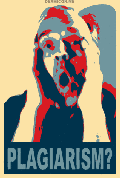FEBRUARY 4, 2009
Private Property—No Trespassing?
On West 53rd Street

This homeowner has posted No Trespassing signs in several places and installed a gate across his driveway. The "No Loud Music. Quiet Zone" hours may give an indication of what the neighborhood is like after dark.
Or maybe it's just someone who's very protective of their privacy.
On the Internet
If you have a Facebook account you'll recognize 25 Random Things. I wrote about it a few days ago. It's an interesting and in my view harmless exercise that involves sharing a list of things about yourself with your friends on Facebook. An article in the New York Times today describes the popularity of 25 Things, calling it a "craze" that's accounted for as many as five million postings in a single week.
The article talks about a few people who prefer to keep these "intimate" revelations private, arguing that they are only appropriate in face-to-face conversation. I have no problem with people who choose not to participate for whatever reason, but I don't find the intimacy/privacy issue at all troubling. If you choose to write your own 25 things you are in control of what you share. Most of us understand that Facebook "Friendships" range from very close to very casual and self-censor the list accordingly.
Of course depending on how you feel about the person and what they choose to reveal, reading a list can be a bit like driving by an accident on the highway. You want to look but are afraid of what you might see. You can always choose to avert your eyes, but it's very human to sneak a peak no matter what. Facebook can be like that.
In the Art world
There are property rights in the art world, protected by copyright laws. The U.S. Copyright office defines it as: "...a form of protection grounded in the U.S. Constitution and granted by law for original works of authorship fixed in a tangible medium of expression. Copyright covers both published and unpublished works." The law is pretty clear than you cannot use an image created by someone else without having their permission.
 Which brings us to Shepard Fairey's famous Obama poster and the question of whether he plagiarized the work of photographer Mannie Garcia. I wrote about this controversy in January, and have since read two more articles, one defending Fairey and the other critical of him.
Which brings us to Shepard Fairey's famous Obama poster and the question of whether he plagiarized the work of photographer Mannie Garcia. I wrote about this controversy in January, and have since read two more articles, one defending Fairey and the other critical of him.
While they are all worth reading, the first two articles spend too much questioning Fairey's motives and politics rather than focusing on the legal and ethical implications of using the work of another artist without his/her permission. The most recent article avoids most of the personal attacks to clearly explain the "fair use" copyright question involved.
If you are an artist, designer, photographer, teacher or student you're right in the middle of this debate whether you realize it or not. Read my original article here, and the updates start here.
Top |
|
![]()